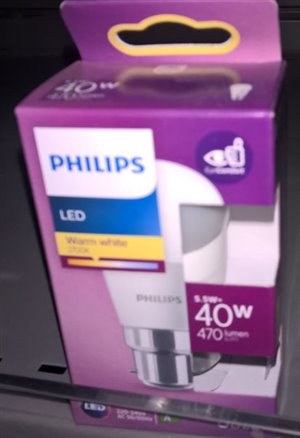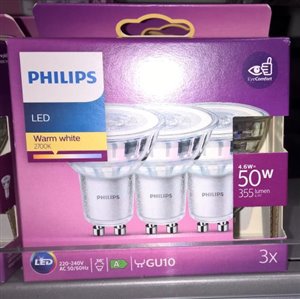

Denis McMahon:
... Whereas on the UK package shown alongside, the equivalent tungsten lamp wattage is shown in much larger type than the actual wattage or lumen output.
This is a practice that I deprecate. By all means state equivalents, but not as the main point of description. To compare the performance of lamps of different types we need to note the lumen output, and this is the figure that should have prominence. Where will we be in ten years' time? Will it still then be appropriate to describe the performance of a lamp in terms of what will by then be a museum piece? Fortunately other manufacturers, notably GE, display this information more sensibly.
Yes, but consider for a moment the The Road Vehicles Lighting Regulations 1989. A vehicle first used before 1 April 1986 must have headlights with a minimum power of 30 W (dipped and main beams). That presents a problem with LED lamps and since 1 Jan this year, LED conversions are an MOT fail. There is no specific requirement concerning intensity. By the way, Vintage, i.e. pre-1931 cars are not included because they never had to have headlamps.
Denis McMahon:
When I was a child I was amused by the way my mother wound up the alarm clock. She would hold the winder and wind the clock.
Maybe this was something to do with the winder turning anti-clockwise and Mum being right-handed. I never really figured it out.
It's often easier that way (especially if your joints have seen better days) - one hand has to twist and the other hold tight to a little key - rather than one hand having to hold tight and twist.
- Andy.
Chris Pearson:. . .
Yes, but consider for a moment the The Road Vehicles Lighting Regulations 1989. A vehicle first used before 1 April 1986 must have headlights with a minimum power of 30 W (dipped and main beams). That presents a problem with LED lamps and since 1 Jan this year, LED conversions are an MOT fail. There is no specific requirement concerning intensity. . .
In 1989 there was hardly any type of headlight other than tungsten or tungsten halogen. Specification in watts was therefore simple and fairly closely defined. There is need for legislation to be brought up to date. Maximum intensity is also a consideration, especially for the dipped beam.
There were similar problems with the introduction of l.e.d. bicycle rear lamps. The early ones attracted criticism that they did not comply with standards. They were in fact unremarkable, apart from the flashing option, and their output was too directional to comply with the standard. Nowadays of course, l.e.d. cycle rear lamps are far, far superior to the 0·6 W filament type that used to comply with the standard of those days.
We're about to take you to the IET registration website. Don't worry though, you'll be sent straight back to the community after completing the registration.
Continue to the IET registration site